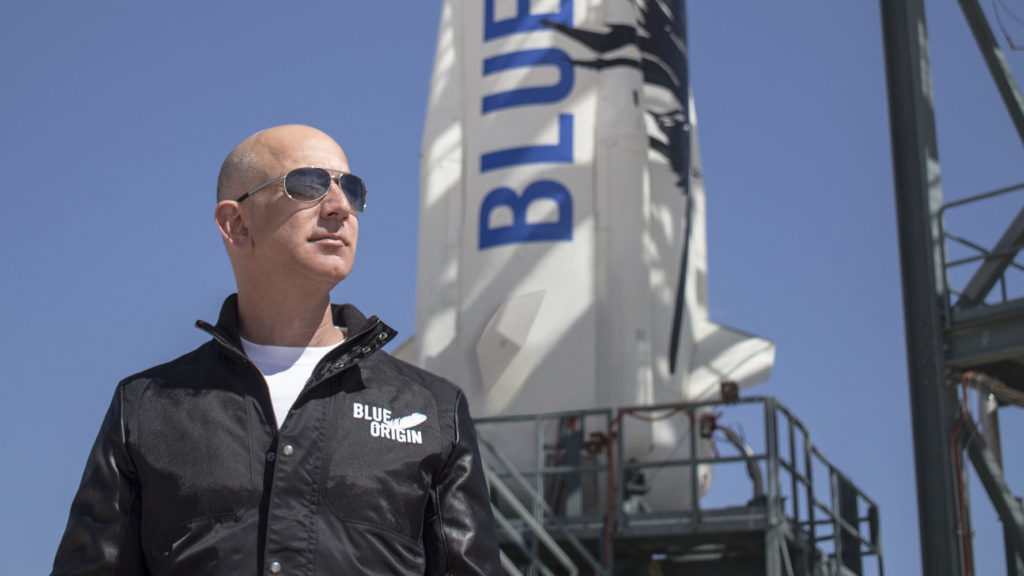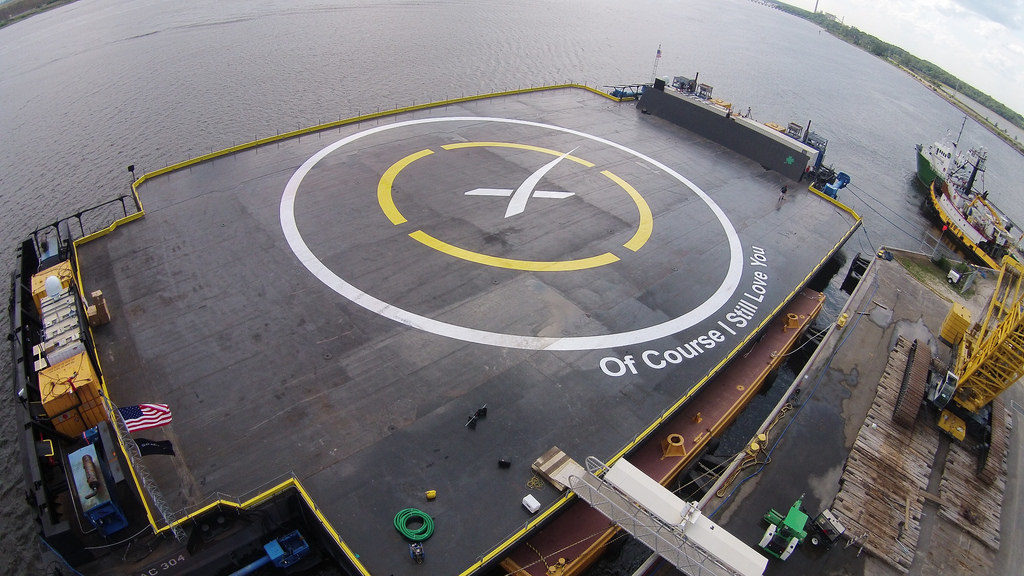

News
Does Elon Musk hold the moral high ground in the commercial space race? Jeff Bezos might disagree.
In the minds of technology-aware people around the globe, Elon Musk holds unique positions in the world of commercial spaceflight:
- Launching and landing rockets.
- Launching and landing reused rockets.
- Launching and landing private rockets funded by the paying customers of a spaceflight company founded with totally private capital.
None of that is to be taken lightly, especially considering Musk’s stated goal of colonizing Mars (and beyond?). All of that combined with the fact that SpaceX’s closest competitors are either centered on rich tourists (Virgin Galactic, Blue Origin) or almost entirely government (contract) funded (Boeing, ULA), and Elon Musk looks to have a type of moral “high ground” over other industry players with a humanity-first approach.
That might not be an entirely fair assessment, though. It’s helpful to first have the full(er) history of commercial spaceflight on hand, and second to have the long-term goals of other players in mind in order to consider where SpaceX really fits in.
A SHORT HISTORY OF COMMERCIAL SPACEFLIGHT
The commercial space industry started shortly after the first satellite was launched in 1957 when the privately-owned Telstar I satellite was put into orbit using a commercially-sponsored rocket in 1962. Congress provided the regulatory framework for such missions shortly after, and hundreds of private satellites were launched in the years following. SpaceX’s earliest predecessor, Space Services, Inc. of America (SSIA), was the first to put a privately owned and operated rocket into space, albeit not into orbit.
- Fun Fact: SSIA is now a star-naming company which has previously contracted cargo space with SpaceX.
After the government provided a better regulatory environment for commercial spaceflight in 1984, SSIA also became the first private company to acquire and use a launch license. In case you’re curious, the rocket didn’t make it to space.
Who was the first private company to make it to orbit on a privately developed rocket, then? That honor would go to Orbital Sciences Corporation (now Orbital ATK, another SpaceX contractor) in 1990, although the rocket was air launched from an airplane. That achievement was followed up by Scaled Composites’ SpaceShipOne in 2004, another air launched vehicle, although it was a rocket-powered aircraft rather than just a rocket. It still holds the title as the first and only privately-funded manned craft to reach space. Virgin Galactic has taken over its successor, SpaceShipTwo, which is still under development with the primary goal of shuttling rich tourists on suborbital thrill rides.
- Fun Fact: United Launch Alliance (ULA), SpaceX’s only bidding competitor for Air Force contracts, was actually formed only to serve government rocket launch needs after legislation was passed requiring NASA to use private spaceflight companies for non-Space Shuttle essential missions. Boeing and Lockheed Martin, traditional government space and defense contractors, came together to form the ULA venture to serve this need, and the rest is mostly guaranteed-NASA-contract-friendly history. Boeing and Lockheed Martin are also the primary contractors developing NASA’s new Space Launch System and Orion crew capsule. For these reasons, I don’t really consider ULA to be a true part of the “new space race”.
SpaceX entered the history records in 2008 when Falcon 1 reached orbit as the first privately developed liquid fueled rocket. Their record list entries have grown ever since:
- 2010, the Dragon capsule was successfully launched into orbit and recovered, making it the first private capsule to do so.
- 2012, the Dragon capsule made a successful trip to the International Space Station (ISS) as the first private spacecraft to do so.
- 2015, Falcon 9 successfully landed after returning from orbit, the first orbital rocket to do so.
- 2017, a reused Falcon 9 core was successfully launched and landed after returning from orbit, making it the first privately owned rocket to do so.
Right before SpaceX’s 2015 landing, Amazon founder Jeff Bezos finally revealed what his secretive space company, Blue Origin, had been up to. Beating SpaceX’s landing by a month, Bezos revealed footage of Blue Origins’ tourist-industry rocket, New Shepard, successfully launching into space and landing itself. The differences between the two companies’ landing achievements are notable; however, Blue Origin still walked away with first prize.
Even so, in commercial spaceflight history, SpaceX’s reputation as an innovator driving the privatization of the space industry is well deserved. But does Elon Musk get to claim a moral “high ground” given SpaceX’s autonomous origins and humanity-centric goals?
JEFF BEZOS IS A DREAMER, TOO
Blue Origin might call that designation into question. How so, especially when Blue Origin’s rocket is a tourist attraction (with no restroom or regurgitation facilities I might add)?
Well, first of all, according to Bezos it doesn’t have to just be a tourist vehicle. In a recent talk given at the 33rd annual Space Symposium, Bezos suggested that the New Shepard could be used as the first stage of another multi-stage rocket rather than just the single stage for his “Astronaut Experience” tourist adventure. That could (potentially) put New Shepard in line with Falcon 9’s customer base.
Most importantly, though, New Shepard is just the beginning of Blue Origin’s long-term goals for space travel. The engine (BE-4) for their expandable heavy launch vehicle, New Glenn, is under development and will be a prime competitor with SpaceX’s Falcon Heavy once in operation.
Back to the “high ground” question, the founder of Amazon had dreams of being a space entrepreneur way before that concept truly existed, and Bezos went into computer science knowing he needed plenty of money to reach that goal. Musk didn’t consider space technology exclusively, but rather went in as a way to be part of pushing humanity’s development forward. Purity of intent? Points for both.
Bezos himself has acknowledged that there are similarities in the goals of both SpaceX and Blue Origin, citing the two companies’ pursuit of vertical landings and quick reusability as the primary ones. For a time, SpaceX was unique in the “new space” arena by not using space tourism as a funding mechanism, but now that they’ve announced their contract to take some very rich customers on a trip around the Moon, they’ve lost that designation. What’s more, Blue Origin has also announced their own Moon program, but it will be to assist with cargo needs for development of a permanent Moon base.
Plus one for Blue Origin.
Both SpaceX and Blue Origin were founded with private funds, and the funding for their developments to date come from a mix of both government and private sources. Technically, Blue Origin is almost entirely privately funded, but they received two rounds of funding from NASA as part of their Commercial Crew Development program that can’t be ignored. Also, their contract with ULA to develop the BE-4 engine (to be used on both Blue Origin’s New Glenn rocket series and ULA’s upcoming Vulcan rocket) makes the designation murky. ULA only launches rockets for government cargo, so whether the money Blue Origin receives from them is truly “private” is a matter of money-trail opinion. On a further note, Bezos has pledged to invest an annual billion dollars of his own funds into Blue Origin.
Plus one for Blue Origin, but plus two for SpaceX for already running a viable, profitable space launch company with plenty of private customers.
What about Mars? Well, Elon Musk has made it no secret that Mars is the primary goal of SpaceX’s technology achievements, and he really, really wants to settle humans there to save the species from potential future disaster. Bezos, on the other hand, has likened the purpose of going to Mars as “because it’s cool”. However, Bezos also wants to do all the “heavy lifting” in building the infrastructure necessary for space commercialization to take off. He used the existing Internet and shipping systems to build Amazon, so now he wants to build the Internet and shipping system equivalents in space with Blue Origin’s technology.
Plus one for both, and I think that means the two are even.
MORAL HIGH GROUND?
The answer to the question of moral standing is then, of course, entirely based on one’s opinion of the future of human spaceflight and the roles we should pursue outside of our home planet. Also as an honorable mention for consideration is one’s economic persuasion in the form of a “chicken or the egg” scenario.
Government has taken us to space and enabled a booming satellite communications market, but we haven’t even returned to the Moon since 1972. Would a privatized space industry have us on Mars already? We can further consider that NASA gave us memory foam, Tang, and underwater pens; however, would better, cheaper versions been developed on their own in the commercial sector as the need for such products for Earth-based activities developed independent of government projects?
Once again returning to the question of a greater-purpose-driven space program, does space tourism lead to trickle-down space exploration, i.e., eventual space travel for the average citizen? Or will it take an “infrastructure first” approach to really make that sort of space travel be a reality?
If a space company claims that its long-term goal is to benefit the future of human kind, the use of space tourism certainly looks to be economically justified as a funding mechanism. But does that then mean that the future of humanity in space is being bred on the “bread” (sorry) of the super-rich?
While it wouldn’t be the first time an industry grew in such a way, there exists a population of folks that prefer a little more “purity” in their spaceflight. Yours truly happens to be such a crab, but I also acknowledge that such sentiments come from growing up only knowing space as taught by a science-centric NASA. Space has always been cool because it gives us a broader perspective of our place in the universe. I never fantasized about opening the first deep space McDonald’s (or Rudy Tyler’s Burger Shack if you understand a bad Space Camp movie reference).
Elon Musk was a game changer in the commercial space world by pursuing rockets as a means of bettering humanity. That gave him a “one-up” over Jeff Bezos and Blue Origin for the purist crowd. Now that SpaceX has added millionaire Moon tourism to its manifest, however, and Blue Origin is moving along into non-tourist space developments to build infrastructure, the field is evening out. It’s also prudent to mention that there are many other rocket companies out there developing private vehicles that we’ll be hearing from eventually.
COMING UP
So what’s up next for SpaceX? The Hawthorne-based rocket company will be back to its regularly scheduled history-making programming this summer with the launch of Falcon Heavy, and later this year Crew Dragon is set to launch, making SpaceX one step closer to launching American astronauts on American soil.
First up, however, Falcon 9 will launch on April 30th, carrying NROL-76 into a secretive orbit from SpaceX’s refurbished Apollo pad, Launch Complex 39A at Kennedy Space Center in Florida. Not many other details are available about payload, though. It’s for the National Reconnaissance Office, so publicly available information is slim. We should see the first stage make a ground landing as consolation – fingers crossed the video doesn’t cut out!
We can also add this launch to the history books again for SpaceX. This is the first payload SpaceX will have ever launched for the U.S. Department of Defense, having beaten ULA for the contract after threatening to sue the Air Force for the right to bid. Watch out, traditional government launch contractors. SpaceX is moving in to your turf. When Blue Origin is ready to start the bidding war, it will be interesting to see how they work out that ULA relationship.
Stay tuned!

Elon Musk
Elon Musk’s X will start using a Tesla-like software update strategy
The initiative seems designed to accelerate updates to the social media platform, while maintaining maximum transparency.

Elon Musk’s social media platform X will adopt a Tesla-esque approach to software updates for its algorithm.
The initiative seems designed to accelerate updates to the social media platform, while maintaining maximum transparency.
X’s updates to its updates
As per Musk in a post on X, the social media company will be making a new algorithm to determine what organic and advertising posts are recommended to users. These updates would then be repeated every four weeks.
“We will make the new 𝕏 algorithm, including all code used to determine what organic and advertising posts are recommended to users, open source in 7 days. This will be repeated every 4 weeks, with comprehensive developer notes, to help you understand what changed,” Musk wrote in his post.
The initiative somewhat mirrors Tesla’s over-the-air update model, where vehicle software is regularly refined and pushed to users with detailed release notes. This should allow users to better understand the details of X’s every update and foster a healthy feedback loop for the social media platform.
xAI and X
X, formerly Twitter, has been acquired by Elon Musk’s artificial intelligence startup, xAI last year. Since then, xAI has seen a rapid rise in valuation. Following the company’s the company’s upsized $20 billion Series E funding round, estimates now suggest that xAI is worth tens about $230 to $235 billion. That’s several times larger than Tesla when Elon Musk received his controversial 2018 CEO Performance Award.
As per xAI, the Series E funding round attracted a diverse group of investors, including Valor Equity Partners, Stepstone Group, Fidelity Management & Research Company, Qatar Investment Authority, MGX, and Baron Capital Group, among others. Strategic partners NVIDIA and Cisco Investments also continued support for building the world’s largest GPU clusters.
News
Tesla FSD Supervised wins MotorTrend’s Best Driver Assistance Award
The decision marks a notable reversal for the publication from prior years, with judges citing major real-world improvements that pushed Tesla’s latest FSD software ahead of every competing ADAS system.

Tesla’s Full Self-Driving (Supervised) system has been named the best driver-assistance technology on the market, earning top honors at the 2026 MotorTrend Best Tech Awards.
The decision marks a notable reversal for the publication from prior years, with judges citing major real-world improvements that pushed Tesla’s latest FSD software ahead of every competing ADAS system. And it wasn’t even close.
MotorTrend reverses course
MotorTrend awarded Tesla FSD (Supervised) its 2026 Best Tech Driver Assistance title after extensive testing of the latest v14 software. The publication acknowledged that it had previously criticized earlier versions of FSD for erratic behavior and near-miss incidents, ultimately favoring rivals such as GM’s Super Cruise in earlier evaluations.
According to MotorTrend, the newest iteration of FSD resolved many of those shortcomings. Testers said v14 showed far smoother behavior in complex urban scenarios, including unprotected left turns, traffic circles, emergency vehicles, and dense city streets. While the system still requires constant driver supervision, judges concluded that no other advanced driver-assistance system currently matches its breadth of capability.
Unlike rival systems that rely on combinations of cameras, radar, lidar, and mapped highways, Tesla’s FSD operates using a camera-only approach and is capable of driving on city streets, rural roads, and freeways. MotorTrend stated that pure utility, the ability to handle nearly all road types, ultimately separated FSD from competitors like Ford BlueCruise, GM Super Cruise, and BMW’s Highway Assistant.
High cost and high capability
MotorTrend also addressed FSD’s pricing, which remains significantly higher than rival systems. Tesla currently charges $8,000 for a one-time purchase or $99 per month for a subscription, compared with far lower upfront and subscription costs from other automakers. The publication noted that the premium is justified given FSD’s unmatched scope and continuous software evolution.
Safety remained a central focus of the evaluation. While testers reported collision-free operation over thousands of miles, they noted ongoing concerns around FSD’s configurable driving modes, including options that allow aggressive driving and speeds beyond posted limits. MotorTrend emphasized that, like all Level 2 systems, FSD still depends on a fully attentive human driver at all times.
Despite those caveats, the publication concluded that Tesla’s rapid software progress fundamentally reshaped the competitive landscape. For drivers seeking the most capable hands-on driver-assistance system available today, MotorTrend concluded Tesla FSD (Supervised) now stands alone at the top.
News
Elon Musk’s Grokipedia surges to 5.6M articles, almost 79% of English Wikipedia
The explosive growth marks a major milestone for the AI-powered online encyclopedia, which was launched by Elon Musk’s xAI just months ago.

Elon Musk’s Grokipedia has grown to an impressive 5,615,201 articles as of today, closing in on 79% of the English Wikipedia’s current total of 7,119,376 articles.
The explosive growth marks a major milestone for the AI-powered online encyclopedia, which was launched by Elon Musk’s xAI just months ago. Needless to say, it would only be a matter of time before Grokipedia exceeds English Wikipedia in sheer volume.
Grokipedia’s rapid growth
xAI’s vision for Grokipedia emphasizes neutrality, while Grok’s reasoning capabilities allow for fast drafting and fact-checking. When Elon Musk announced the initiative in late September 2025, he noted that Grokipedia would be an improvement to Wikipedia because it would be designed to avoid bias.
At the time, Musk noted that Grokipedia “is a necessary step towards the xAI goal of understanding the Universe.”
Grokipedia was launched in late October, and while xAI was careful to list it only as Version 0.1 at the time, the online encyclopedia immediately earned praise. Wikipedia co-founder Larry Sanger highlighted the project’s innovative approach, noting how it leverages AI to fill knowledge gaps and enable rapid updates. Netizens also observed how Grokipedia tends to present articles in a more objective manner compared to Wikipedia, which is edited by humans.
Elon Musk’s ambitious plans
With 5,615,201 total articles, Grokipedia has now grown to almost 79% of English Wikipedia’s article base. This is incredibly quick, though Grokipedia remains text-only for now. xAI, for its part, has now updated the online encyclopedia’s iteration to v0.2.
Elon Musk has shared bold ideas for Grokipedia, including sending a record of the entire knowledge base to space as part of xAI’s mission to preserve and expand human understanding. At some point, Musk stated that Grokipedia will be renamed to Encyclopedia Galactica, and it will be sent to the cosmos.
“When Grokipedia is good enough (long way to go), we will change the name to Encyclopedia Galactica. It will be an open source distillation of all knowledge, including audio, images and video. Join xAI to help build the sci-fi version of the Library of Alexandria!” Musk wrote, adding in a later post that “Copies will be etched in stone and sent to the Moon, Mars and beyond. This time, it will not be lost.”










